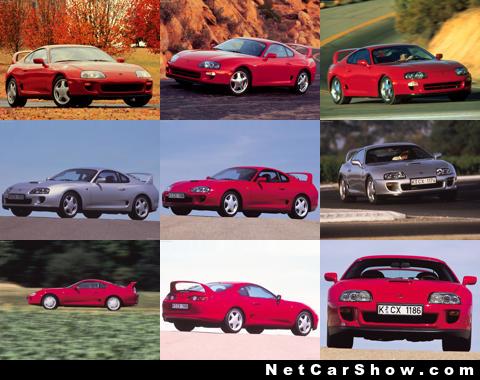Toyota Supra
With performance equal or superior to many of the world's most exotic sports cars, it would have been easy for Toyota engineers to forget that Supra is still a Toyota at heart. But because it is a Toyota, they were able to incorporate speed, style, quality, dependability and Toyota's legendary reliability.
Supra is powered by a high-performance, twin-cam, in-line six-cylinder, 24-valve, electronically fuel-injected engine. In normally aspirated trim, it produces 220 horsepower at 5,800 rpm and a maximum of 210 lb./ft. of torque at 4,800 rpm. In addition to a specially tuned intake system, it incorporates split-exhaust manifolds for reduced engine back pressure, enhanced power output and greater fuel economy.
The normally-aspirated Supra is available with either a five-speed manual and four-speed automatic transmission.
Supra's turbocharged engine produces 320 horsepower at 5,600 rpm and 315 lb.-ft. of torque at 4,000 rpm. Supra's twin-sequential intercooled turbos provide quick response at low engine speeds and high-volume output at increased engine speeds. During low-speed operation, only one turbocharger operates, using less exhaust energy to improve response and torque from a standing start. In the middle-speed range, the second turbo comes to idle at a pre-set exhaust pressure for a smooth transition from the primary to the secondary turbocharger. Both turbos operate at full boost in the high-speed range.
Due to ever-increasing emission requirements, the Turbo's six-speed manual transmission has been discontinued. The four-speed electronically controlled automatic has been developed to extract the maximum from this engine. The automatic's control system adjusts shift timing, lock-up timing, hydraulic pressure for the clutch and brake, and engine torque in order to deliver virtually seamless shifts. In manual mode, selected by a console button, the transmission shifts quickly into each gear as it is selected. Shift times in manual mode are quicker than in fully-automatic mode.
To save weight, Toyota engineers chose to use a serpentine belt-drive system to power engine accessories. The accessories are in turn attached directly to the cylinder block instead of to brackets. Aluminum engine mounts also save weight.
Standard on Turbo models is a defeatable electronic traction control system which automatically senses wheel spin, limits power to prevent it and maintains traction.
Supra is equipped with a sophisticated four-wheel fully independent suspension with coil-over shock absorbers with hollowed front and rear stabilizer bars for less weight. Race-derived light-alloy double-wishbone suspension at all four wheels helps keep Supra's driver in control. This system provides a comfortable and balanced ride under all conditions.
Steering is variable power rack-and-pinion providing necessary control at higher speeds, while requiring only a light touch at low speeds.
With Supra, safety is as important as performance. Included on all models are driver- and passenger-side airbag Supplemental Restraint Systems, high-penetration headlamps and lateral G-sensing four-sensor, four-channel anti-lock brakes (ABS).
Supra's interior is designed for the serious driver and allows full control over the vehicle whether stuck in rush-hour traffic or carving through canyons. The seats in the Supra were designed to fit all occupants, and feature manual adjustments on standard seats, power operated when the optional leather trim package is ordered. New for 1996 is the addition of cloth upholstery on the rear seat of those vehicles without the leather package, rather than the previous vinyl covering. The instrument panel is angled to allow greater visibility of gauges and access to ventilation and sound-system controls.
Supra's standard audio system is a Deluxe AM/FM/Cassette sound system with power antenna and six speakers. Sport roof and Turbo models are equipped with a Premium ETR/Cassette with six speakers, a power antenna, a diversity antenna for optimized FM reception and a built-in theft deterrent system. The Premium system is optional on non-turbo hardtop models, and a Premium ETR/Cassette/CD unit with seven speakers is optional on all models.
All Supras come standard with power-operated windows, door locks and mirrors, cruise control, a tilt steering wheel, a lockable glove box with light, remote fuel door and trunk releases and an auto-off feature that extinguishes the headlamps when the key is removed from the ignition and the driver's door is opened. Also standard is a theft deterrent system, digital clock, a driver-side foot rest, a light in the hatch area, variable intermittent windshield wipers and an intermittent rear window wiper.
Gauges are comprised of a centrally mounted tachometer, speedometer, water temperature, fuel level and digital odometer and dual tripmeter.
Tires for the normally aspirated Supra are 225/50ZR16 on 16x8-inch alloy wheels in front and 245/50ZR16 on 16x9-inch alloy wheels in the rear.
The normally aspirated Supra is available with or without a sport-roof.
The Supra Turbo includes those items on the normally aspirated model, and adds larger brakes front and rear. Tires for Supra Turbo are 235/45ZR17 in front, on 17x8-inch alloy wheels, and 255/40ZR17 in the rear on 17x9.5-inch alloys.
The Turbo model also adds a limited-slip differential and traction control system, a specially tuned sport suspension, an engine oil cooler and a 100-ampere alternator.
The Turbo model also is available with only a Sport Roof.







































